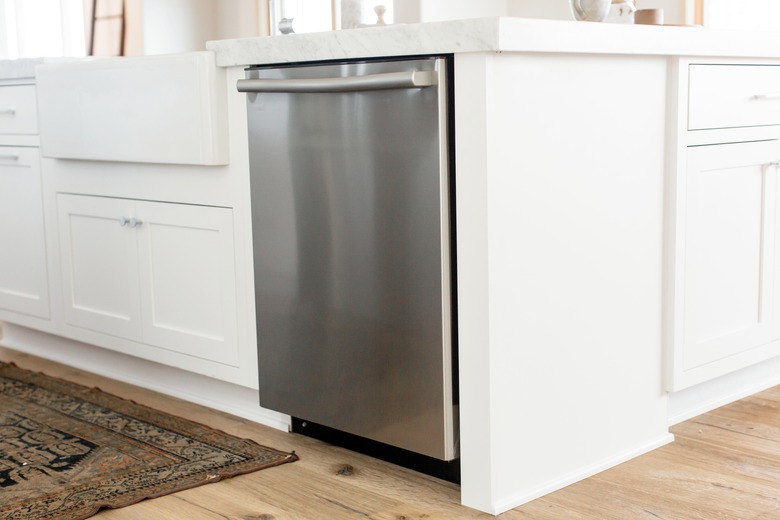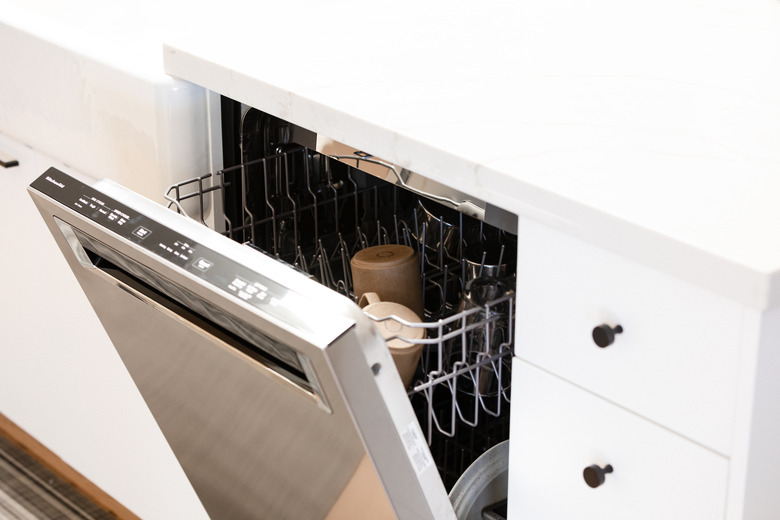The Best Dishwasher: 2022 Buying Guide
We may receive a commission on purchases made from links.
They say necessity is the mother of invention, and it's certainly true of the dishwasher. In 1886, Josephine Cochran was looking for a faster way to wash the dishes and to do so with less breakage. When she didn't find a solution, she created her own and invented the first dishwasher to clean dishes rather than just rinse them. She filed a patent and went on to create her own company, and today we know that company as KitchenAid.
Josephine's dishwasher was mechanical and required users to turn a hand crank, but it was still faster than washing dishes by hand. The dishwashers of today are much more high-tech and include features Josephine probably never even imagined. Learning about these choices will help you pick the best dishwasher for your needs.
The good news is that most of the dishwashers on the market today do an excellent job of cleaning the dishes. The best dishwasher for you in 2022 will depend on your budget and which features matter to you the most. Whenever possible, opt for a unit with a stainless steel tub, multiple rack configurations and a drain with a built-in blade for grinding food debris.
Portable, Built-In or Drawer Dishwashers
Portable, Built-In or Drawer Dishwashers
The first step in dishwasher shopping is to decide what type of appliance you want. Built-in dishwashers are by far the most popular and will give you the most choices. In this arrangement, the dishwasher slides into an opening beneath your countertop and gets permanently plumbed in. According to Best Buy, standard built-in dishwashers measure 24 inches wide and 35 inches high. You can get a smaller dishwasher in a width of 18 inches if you have limited space.
Portable dishwashers are another option and work well when you're renting or don't have any cabinet space to spare. These free-standing units come on wheels. When you want to use the dishwasher, you roll it over to the kitchen sink, hook a hose to the sink faucet and then plug the dishwasher into an electrical outlet. Portable dishwashers won't eat up cabinet space under your kitchen counter, but you'll still need to store the dishwasher when you're not using it, which can be difficult in small kitchens.
Your third choice is something called a dishwasher drawer. Measuring 24 to 30 inches wide and about 20 inches tall, a dishwasher drawer nestles into your cabinets for a more discreet look. If you prefer and have the space, you can also set the appliance on your counter. When you wish to use it, you simply pull it open like a drawer and load your dishes into it. Given their compact nature, you won't be able to fit most pots and pans in a dishwasher drawer, however, and you won't have many choices because as of 2020, only Fisher & Paykel makes these appliances.
Modern Dishwashers: Beautiful Inside and Out
Modern Dishwashers: Beautiful Inside and Out
Modern dishwashers come in the same finishes as other kitchen appliances, so it's easy for you to make your dishwasher match. Standard colors include white, black and stainless steel. Matte finishes and black stainless steel finishes are also available, as is smudge-resistant stainless.
If your budget allows, you can also purchase a dishwasher with an unfinished door. This allows you to purchase and install a custom panel that matches the facing on your kitchen cabinets. This option can be pricey, but it does add a luxury feel to your kitchen.
Although you're the only one who will see it, consider choosing a dishwasher with a stainless steel tub rather than a plastic one. Both will last for many years and should outlive your dishwasher, but plastic tends to stain and discolor over time. Pulling dishes out of a dingy-looking dishwasher may leave you feeling like the dishes aren't clean.
Dishwasher Rack Considerations
Dishwasher Rack Considerations
When dishwasher shopping, make sure you take note of the racks. Adjustable racks are a must-have, but you'll need to figure out which adjustments matter to you. In some dishwashers, you have the option of raising or lowering the entire rack to accommodate large pans and casserole dishes. Other dishwashers feature tines that fold flat to make room for larger dishes, and some let you remove the tines entirely.
Look for a silverware basket that you can easily move or remove for added flexibility. Some silverware racks even have lids you can close for keeping small items in place during turbulent wash cycles.
One of the best features you can get is a tine-lowering/water jet combination. Dishwashers with this feature have two or three powerful water jets at the bottom rear of the tub. The tines in front of these jets fold down and out of the way, allowing you to put dishes with baked-on food directly in front of them for an extra power boost.
Dishwasher Noise Level
Dishwasher Noise Level
In the past, dishwashers were quite loud and made conversations in the kitchen somewhat difficult. Fortunately, that's no longer the case. Sound dampening in dishwashers is now the norm, and even budget-friendly models run fairly quiet.
According to CNET, even today's most basic dishwashers run at about 50 decibels (dBs). This is about the same noise level as a conversation. Unless you have exceptional hearing, you shouldn't be able to hear a 50 dB dishwasher running from the next room.
Dishwashers in the $600 to $900 range tend to run in the 40 dB range. These quiet dishwashers are quiet enough that you can easily hold a conversation right next to them when they're running. If you bump up to a four-digit price tag, you can expect a dishwasher that runs less than 40 dBs. Those units are the quietest and hard to hear even when you're standing right beside them.
Dishwasher Efficiency
Dishwasher Efficiency
In the United States, the federal government has made it much easier to find an energy-efficient appliance. All dishwashers get an EnergyGuide label to help you comparison shop. On the top left-hand corner of the label, the dishwasher's special features are listed to help you compare apples to apples, so to speak.
The label also tells you how much energy the appliance uses on average and how much that energy costs. This statistic is only updated every five years, however, and is based on average utility prices in the U.S. Use this number for comparison to other dishwashers but don't expect it to accurately predict your energy bill.
Check the bottom right corner of the EnergyGuide label for an Energy Star logo. Appliances bearing this symbol are more energy efficient than standard comparable dishwashers.
No Need to Rinse
No Need to Rinse
Thankfully, the days of wasting time and water by rinsing your dirty dishes before putting them in the dishwasher are over. In fact, doing so can actually make your dishes dirtier. The reason is something called a turbidity sensor or soil sensor.
It's kind of gross to think about it, but food particles swirl around in the water while your dishwasher is running. As the dishes get cleaner, the amount of food in the water decreases. Turbidity sensors measure how many food particles are present in the water. If there are many, the dishwasher cranks up the cleaning to get rid of them.
If you rinse all the food debris off your dishes before loading the dishwasher, the turbidity sensor won't find many food particles and may give your dishes only a light cleaning — perhaps too light to get them as clean as you want them.
Other Dishwasher Features to Consider
Other Dishwasher Features to Consider
Although not strictly necessary, there are some other dishwasher features that are nice to have. One is a food-grinding drain. These drains work like mini garbage disposals, chewing up any food particles before sending them down the drain. This helps prevent clogs and backups. You can also opt for a regular drain filter but make sure it's easy to take in and out for cleaning.
You can also choose where you want your controls. Some dishwashers place their controls on the front, and others tuck them on top of the door, keeping them hidden when the dishwasher is closed. Hidden buttons add a sleek look, but this option is entirely a matter of personal taste.
Some dishwashers now come with a small third rack. This rack is excellent for cleaning silverware and small items but consider it carefully because it can make cleaning larger dishes more challenging if it takes up too much space.
Smart and Connected Dishwashers
Smart and Connected Dishwashers
Like everything else these days, some dishwashers now come equipped with smart technology that allows them to connect to your home's Wi-Fi. Unless you live for tech, there are probably not many reasons to add this feature to your dishwasher.
Most smart dishwashers now let you use your phone to check on your dishwasher from anywhere. This app will tell you exactly where your dishwasher is in the cleaning cycle, although why you need this information while you're out and about remains unclear. Whirlpool and GE currently offer dishwashers that connect to Amazon Dash as well. You fill the large detergent holder, and when it starts to run low, the dishwasher automatically orders more for you.
Most of this new dishwasher tech seems unnecessary, but Whirlpool's 6th Sense Live is the exception. This handy gadget connects to the internet and researches when the energy consumption in your area is the lowest and least expensive. It then programs itself to run at that time and save you money. If you have to have a smart dishwasher, this is the tech to have.
The Best Dishwasher Brands of 2022
The Best Dishwasher Brands of 2022
As is true whenever you buy a major kitchen appliance, it's best to go with a name you know. Off-brands may not work as well, and it can be much more difficult to find parts and service for obscure units.
Bosch and GE both have good reputations and are known for producing dishwashers with exceptional rack flexibility. Kenmore has added fans to the drying cycles, making their units better at drying dishes than many other dishwasher brands. KitchenAid's most recent claim to fame is a dishwasher that recycles rinse water, using 33 percent less water per load.
When tested by Consumer Reports, Bosch, Whirlpool and Thermador came out on top. Testing also found that spending more doesn't always mean getting more. Although they are considered high-end brands, Viking, Electrolux and Samsung all tested poorly when it came to reliability. If you want a drawer dishwasher, Fisher & Paykel is currently your only choice. Unfortunately, these dishwashers received poor reliability ratings.


